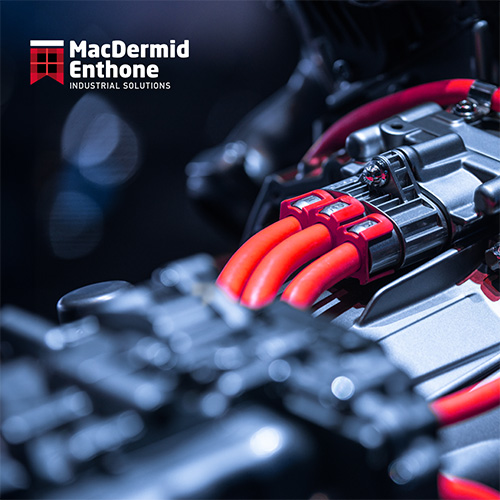AI and Industry 4.0 are revolutionizing manufacturing with predictive maintenance, digital twins, and smart automation.

By Timothy Gotsick, Vice President of Technology and Innovation
Broadly speaking, Industry 4.0 refers to the digitization of manufacturing (1). There are a lot of subheadings under that topic, but automation, digital communication, and advanced manufacturing technologies like 3D printing are prominent examples of this still-evolving concept. Industry 4.0 refers to a level of process automation that goes well beyond conventional lean manufacturing concepts and veers off into objectives like the fully automated ‘dark factory’ (2), where you can run an entire production shift in the dark, as nearly no human intervention is required. The potential appeal of such manufacturing operations is clear, but there is a large gap that must be crossed to get from idea to operation.
Despite our human foibles, like the need for sleep and a tendency to grow bored with repetitive tasks, we are remarkably versatile and adapt quickly to change. These capabilities are so common that we tend to take them for granted until we try to program machines, where we then realize how many algorithms are needed to describe simple decision-making processes that humans can perform almost subconsciously. Connecting a relatively simple multi-step manufacturing process for autonomous operation has proven to be extremely challenging.
Digital systems already have humans beat when it comes to data communication: even the fastest human reader absorbs information at very low rates compared to the Gigabytes per second (Gb/s) data transmission rates that computers commonly achieve. Our ability to retain the spoken word is no faster. You can download a Taylor Swift album in seconds, but you must listen for 65 minutes to truly decide whether you think ‘The Tortured Poets Department’ is better than ‘Reputation’.
AI’s ability to process and retain information may be the ‘missing link’ that moves Industry 4.0 from a compelling concept into a practical reality. AI tools enable systems to process data and make more complex decisions in response to the information that is being collected. One of the earliest and most impactful applications of this capability is predictive maintenance (3). With automation comes an increase in machinery. While machinery doesn’t eat or sleep, it does wear out if it is not properly maintained. The worst thing that can happen in a tightly interconnected manufacturing process is unplanned downtime, exceeded only by a catastrophic failure of a key component that shuts down an entire production line or causes collateral damage. The need to plan for this downtime is critical, and technology is making this process easier.
With AI, an almost limitless number of sensors can be monitored in real-time for any deviations from historical precedent, signaling that a component requires service. Your manufacturing history has now become a resource for the AI tool as it can train itself to recognize the data signatures that precede failure well in advance of a catastrophic incident. Many mechanical failures look sudden to humans, but that is only because we cannot sense all the subtle signals that precede failure due to our inability to monitor multiple data streams continuously for long periods of time. Vibration, temperature, acoustic, and optical sensors can all monitor components and interactions between systems that would either escape our notice or be far too tedious for human attention.
AI is already being leveraged in other critical areas such as production scheduling and inventory management. Ensuring the right inventory is in the right place at the right time is a fundamental struggle for organizations of any size. While simple in concept, it can be incredibly complex in practice. Furthermore, it is seldom static; just when you think that your supply chain is under control, a butterfly flaps its wings in Ecuador and everything changes. AI enables a nearly limitless number of inputs to be evaluated and compared, and makes adjustments according to your unique set of rules and business requirements. You can have as much or as little human oversight of these decisions as you wish. Currently, it is still considered best practice to have human oversight for consequential decisions, but as these systems improve and familiarity with them grows, more automation will be possible and should be expected.
Along with its use in inventory management applications, AI is being utilized to create ‘digital twins’ of manufacturing facilities (5). Whether based on historical data or projected layouts, a copy of a manufacturing operation can be made in a virtual world. This virtual operation can serve as a test bench for exploring optimization opportunities. In the same way that spreadsheets revolutionized the world of finance by enabling the modeling of nearly any conceivable scenario, virtual manufacturing plants make it possible to safely, quickly, and cost-effectively explore a wide range of potential changes. Imagine standing in front of a Board of Directors with a capital request that includes a fully modeled scenario showing demonstrated savings. AI makes this vision possible.
The promise of AI in Industry 4.0 is enormous, and many companies are already experimenting with or exploiting these new technologies. However, we cannot see this change through rose-colored glasses. There are operational risks that need to be considered and even some macroeconomic and ethical concerns that may give us pause.
In an operational sense, the security of your digital data becomes more critical than ever before (6). Yes, it’s bad if someone crashes your website, but it will be far worse if they hijack your production facility and hold it for ransom – or destroy it intentionally to cripple your business. Every smart device on your network now needs to be hardened against malicious hackers, because every one of those devices represents a potential vulnerability.
Yet the biggest danger today is the unwavering trust in AI technology. There are amazing things being done with AI already, and its speed and capability are impressive. However, we are still in the early days of these tools, and one should not mistake the confident assertions of AI for reality quite yet. Ask an AI platform a question, and it will deliver an answer. Yet it is not difficult to find examples (7) ranging from comical to horrifying about AI gone wrong. We interact with AI nearly every day, but one must operate with a bit of skepticism before handing over operations completely.
The rise of AI in manufacturing carries profound societal implications. A ‘dark factory’ might be a lean engineer’s dream, but it means that the correlation between manufacturing and employment will be very different from what it used to be. Technology evolves much faster than humans, and the same desire for intellectual stimulation and social interaction that makes us less reliable than robots will likely make us a bit more agitated when our roles suddenly change or disappear. As with most technological revolutions, serious attention needs to be paid to what we do with all of the human capital, experience, and ambition that will be freed by AI. It is important to remember that while this could permit the creation of entirely new industries, the transition period might be bumpy.

About the Author:
Timothy Gotsick is the Vice President of Technology and Innovation at MacDermid Enthone Industrial Solutions, where he leads global research and development initiatives in surface finishing technologies. With a Ph.D. in Chemistry from the University of Tennessee, Knoxville, and a B.A. from Reed College, he has over two decades of experience in the chemical and surface finishing industries. Timothy has managed international teams across Europe and Asia, driving innovation in digital flexographic printing and sustainable chemical processes. His work focuses on advancing technologies that support the electrification of transportation and the development of sustainable power generation solutions.
References
From tradition to transformation Sequoia Brass & Copper has stood for excellence in American manufacturing. In this episode, we sit down with Kim MacFarlane, President of Sequoia Brass & Copper, to hear the inspiring story of a family-owned company founded by her father, built on craftsmanship, trust, and a relentless commitment to quality. Kim shares how she’s guided the company through the challenges of modern industry while honoring its heritage, and how the next chapter will be carried forward by her son Kyle. This is more than a story of brass and copper; it’s about resilience, innovation, and the enduring strength of family legacy. If you’ve ever wondered how tradition can meet the demands of today’s industry hit play and be inspired.